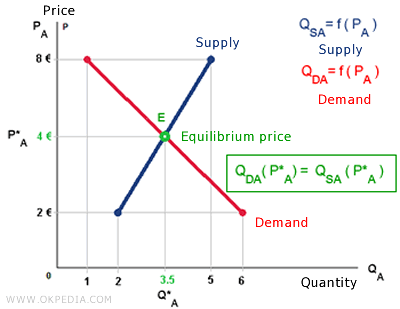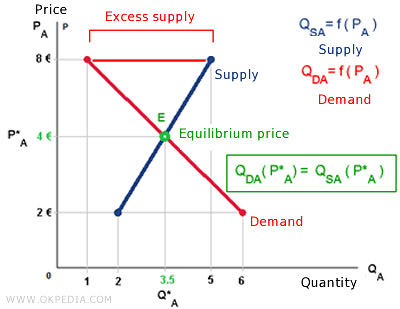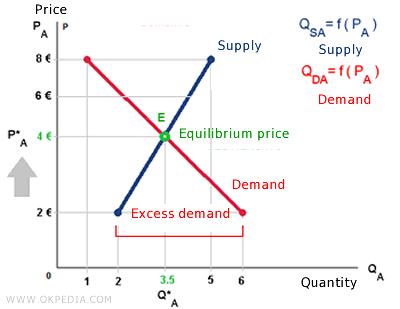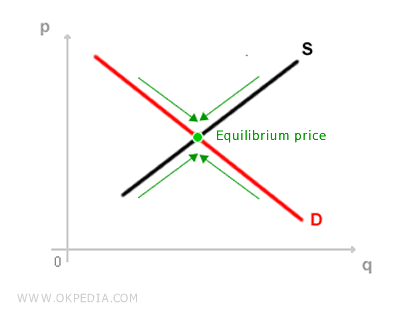Market Equilibrium
Market equilibrium occurs when the quantity demanded of a good matches the quantity supplied. The conditions that lead to equilibrium in a market are a key focus of political economy studies.
At the equilibrium price, buyers are able to purchase all the quantity of the good they want, and sellers can sell all the quantity they plan to offer, without any excess demand or supply.
The Market or Equilibrium Price
Market equilibrium happens at a certain market price, known as the equilibrium price.
Any market can be represented by the following economic-mathematical model:
QDA = f(PA)
QSA = f(PA)
The model consists of two functions:
- The demand function. The first function determines the quantity of the good demanded (QDA) by buyers.
- The supply function. The second function determines the quantity of the good supplied (QSA) by sellers.
Both functions use the price of the good (PA) as the independent variable.
What is the price? In monetary economies, the price of a good is the amount of money a buyer gives to purchase one unit of the economic good.
Therefore, the market is in equilibrium when the price PA equals the quantity demanded and supplied:
QDA(P*A) = QSA(P*A)
This price (P*A) is called the equilibrium price.
At the equilibrium price, negotiations between buyers and sellers end, and the exchange takes place.
Why do negotiations end? At the equilibrium price, negotiations stop because each participant is able to buy or sell the amount they had planned. At the market price P*, buying and selling plans are perfectly aligned, leaving no need for anyone to alter their decisions.
Graphical Representation of Market Equilibrium
Market equilibrium can be graphically represented on a Cartesian plane. The horizontal X-axis measures the quantity demanded and supplied of good A, while the vertical Y-axis represents the price PA.

The graph shows both the demand curve and the supply curve for good A.
The demand curve shows the quantity demanded at different price levels, while the supply curve shows the quantity supplied at varying prices.
These curves are known as the demand and supply curves, respectively.
The point where the demand curve intersects the supply curve determines the market equilibrium at point E. At the equilibrium point, the quantity demanded equals the quantity supplied.
This results in the equilibrium quantity Q* and the market equilibrium price P* for the good.
The pair of values (Q*, P*) eliminates any excess demand or supply.
The Process of Market Equilibrium Formation
To understand the dynamic process of reaching equilibrium, we analyze a disequilibrium situation using dynamic analysis.
What is dynamic analysis? Dynamic analysis studies the adjustment process toward equilibrium. It differs from comparative statics, which only looks at the differences between the initial and final equilibrium positions.
A situation of disequilibrium occurs when a price P results in a quantity demanded that differs from the quantity supplied.
QDA(PA) ≠ QSA(PA)
In such cases, there is either excess supply or excess demand.
Excess Supply
In the previous graph, when the price of the good is set at 8 euros, consumers only want to purchase one unit of good A, while sellers plan to sell five units.
At this non-equilibrium price, there is an excess supply.

This is considered an unstable equilibrium because market forces will push participants to change their decisions.
To sell the four unsold units, the seller must reduce the price from eight to six euros. The price reduction has two effects:
- It increases the quantity of the good demanded;
- It decreases the production and supply of the good.
These gradual price adjustments guide the market toward equilibrium (E).

Market forces bring the market into balance.
Point E represents a stable equilibrium.
An equilibrium is stable when participants no longer have any reason to change their decisions.
Excess Demand
When the market price is 2 euros, consumers want to buy six units of good A, but sellers only plan to sell two units.
This disequilibrium situation results in excess demand.

This is also an unstable equilibrium. Excess demand encourages sellers to raise the price of the good.
Continuous price changes drive the market toward the equilibrium point E.
Point E represents a stable economic equilibrium.
Market Forces Drive the Market Toward Equilibrium
In disequilibrium situations, market forces adjust prices, gradually reducing excess demand or supply until the market reaches equilibrium.
Adam Smith described market forces as an invisible hand that spontaneously and automatically drives market prices toward equilibrium, without government intervention.
The Stability of Equilibrium
Stability is one of the key conditions for market equilibrium.
In the market equilibrium (E) shown in the previous diagram, participants have no reason to change prices or the quantities they demand or supply. For this reason, the equilibrium is stable.

In disequilibrium situations, stability conditions are never met because excess demand or supply leads participants to adjust the market price.
The stability of equilibrium and market interdependence. Equilibrium in a single market is a partial economic equilibrium. In reality, multiple markets exist, and they are interconnected. Thus, an equilibrium might be stable in a partial analysis but unstable in a general analysis. For this reason, market equilibrium stability should only be considered in the context of general equilibrium, where all markets are in balance.
Types of Market Equilibrium
In economic theory, various types of market equilibrium can be distinguished.
Based on the number of markets analyzed, equilibrium can be either partial or general.
- General economic equilibrium. This refers to the price vector (P1, P2, ... , Pn) that leads to simultaneous equilibrium in all markets. This condition ensures the balance between supply and demand for every good. General equilibrium is also known as Walrasian equilibrium, named after Léon Walras.
- Partial economic equilibrium. This refers to the price (P) that allows equilibrium in a single market. This condition ensures the balance between supply and demand for a specific good. This type of market equilibrium is central to Marshall's studies.
Based on equilibrium conditions, it can be static or dynamic.
- Static economic equilibrium. This market equilibrium occurs when all variables are already balanced. This type of equilibrium is mainly used in comparative statics in microeconomics.
- Dynamic economic equilibrium. This refers to the study of movement toward an equilibrium position and its stability over time. This type of equilibrium is studied in dynamic analysis in macroeconomics and econometrics.
